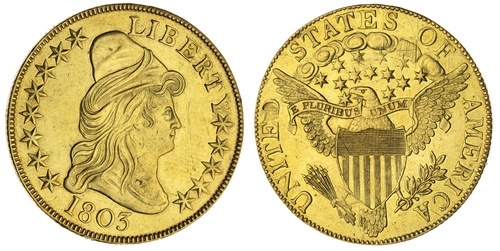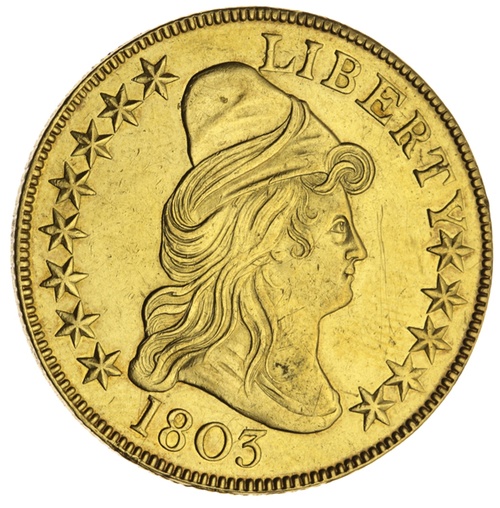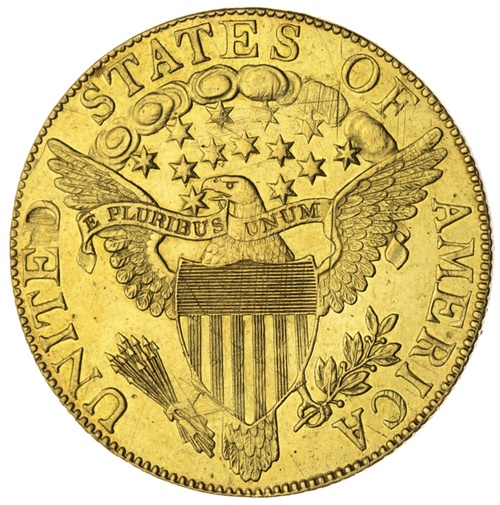Auction: 22007 - British and World Coins and Commemorative Medals Autumn Auction
Lot: 367
(x) NGC AU58 | USA, Gold Eagle of Ten-Dollars, 1803 $10, 'Large Stars, Extra Star on Cloud', Philadelphia, by Robert Scot and Johann Matthias Reich (John Reich), 'turban head' draped bust right, LIBERTY and thirteen stars surround, rev. UNITED STATES OF AMERICA, Eagle with wings outstretched, E PLURIBUS UNUM on scroll gripped in beak, large stars above with additional star in rightmost cloud [a test puncheon (?)], edge straight milled, 17.48g, 6h (Bass-Dannreuther [2006] 5 [BD-5, High R.4], die state g/a; J C Randall [June 1885], lot 859; Breen 6845; Taraszka 30; PCGS 45739; NGC ID 262A), overt adjustment marks to reverse, otherwise lustrous and quite brilliant, approaching extremely fine, yet extremely rare, with only 15,017 pieces originally struck from six die marriages, but fewer than a hundred believed extant today; thus the date very seldom encountered at worldwide public sale, the reverse variety prohibitively scarce in this and higher grades; this example fresh to market for the first time in nearly half-a-century, in NGC holder, generously graded AU58 (Cert. #6380987-001)
Purchased
Seaby, 1975 - £1,570 [Inventory no. 751308]
Although the BD-5 [large stars] die marriage has been known since the age of Edgar Adams and Waldo Newcomer, it was not until 1966 that Harry W. Bass, Jr. confirmed their observations of an additional small star in the rightmost cloud. Why the die sinker placed the anomalous star within the cloud will likely never be known, but such anomalies exist in many 18th and 19th century coinage series of the United States, and are consequently exceedingly sought after by type collectors. Conjecturally, the engraver may have wanted to test the pre-existing small star punch (used for the first four reverse dies) in a seemingly inconspicuous place, or maybe it was a secret mark like the notched thirteenth star that became John Reich's secret signature. Why the Mint changed star punches at all is a more intriguing and as yet unanswered question, but the reason was most likely practical or logistical, that is to say the replacement of a broken tool as opposed to a conscious style change. Six different die marriages were used to strike 1803-dated eagles. The first four in the emission sequence are of the Small Reverse Stars type, and the it is believed that they are twice as plentiful as the present coin, that is to state of an original mintage, it is believed some 10,000 were contributed from the first four 'Small Stars' reverse dies, and the remainder by the pair of larger reverse stars dies (BD-5 and BD-6). This example is fresh to market, having remained in the collection of the Late George Webber, economic and financial historia since purchase from the London dealership, Messrs Seaby in 1975.
Subject to 5% tax on Hammer Price in addition to 20% VAT on Buyer’s Premium.
Sold for
£18,000
Starting price
£8000









